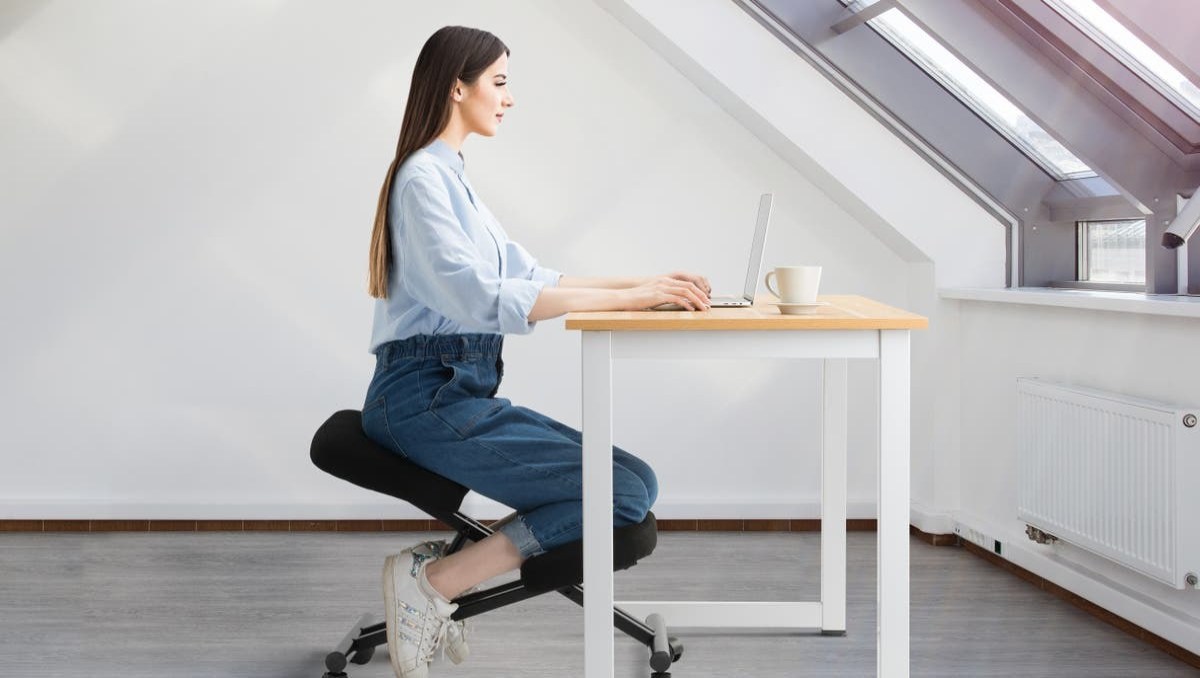If you’ve ever tried a kneeling chair, you know it’s not your average office seat. With its unique design that promotes better posture and eases back tension, it can be a game-changer—if you’re using it the right way. But here’s the catch: many people hop on a kneeling chair without really knowing how to sit on it properly, which can lead to discomfort or even negate its benefits.
Key Takeaways:
- The best way to sit on a kneeling chair is to sit on the seat with your knees and shins on the pads, keeping your weight balanced between your bottom and knees.
- The benefits of using a kneeling chair include improved posture, reduced back pain, enhanced ergonomics and core strength, and increased circulation.
- If pain persists or you have pre-existing conditions, consult a medical professional or ergonomist.
In this article, we’ll walk you through the best way to sit on a kneeling chair so you can get the most out of its ergonomic benefits.
What is A Kneeling Chair?
A kneeling chair is a unique chair designed to promote better posture and reduce strain on the lower back. It typically consists of a forward-sloping seat and a knee rest, encouraging a more open hip angle and a more upright spinal position.
The user’s weight is distributed between the seat and the knee rest, creating a sitting experience that can be more ergonomic compared to traditional chairs. Kneeling chairs are often used as an alternative to conventional office chairs and are believed by some to offer numerous health benefits.
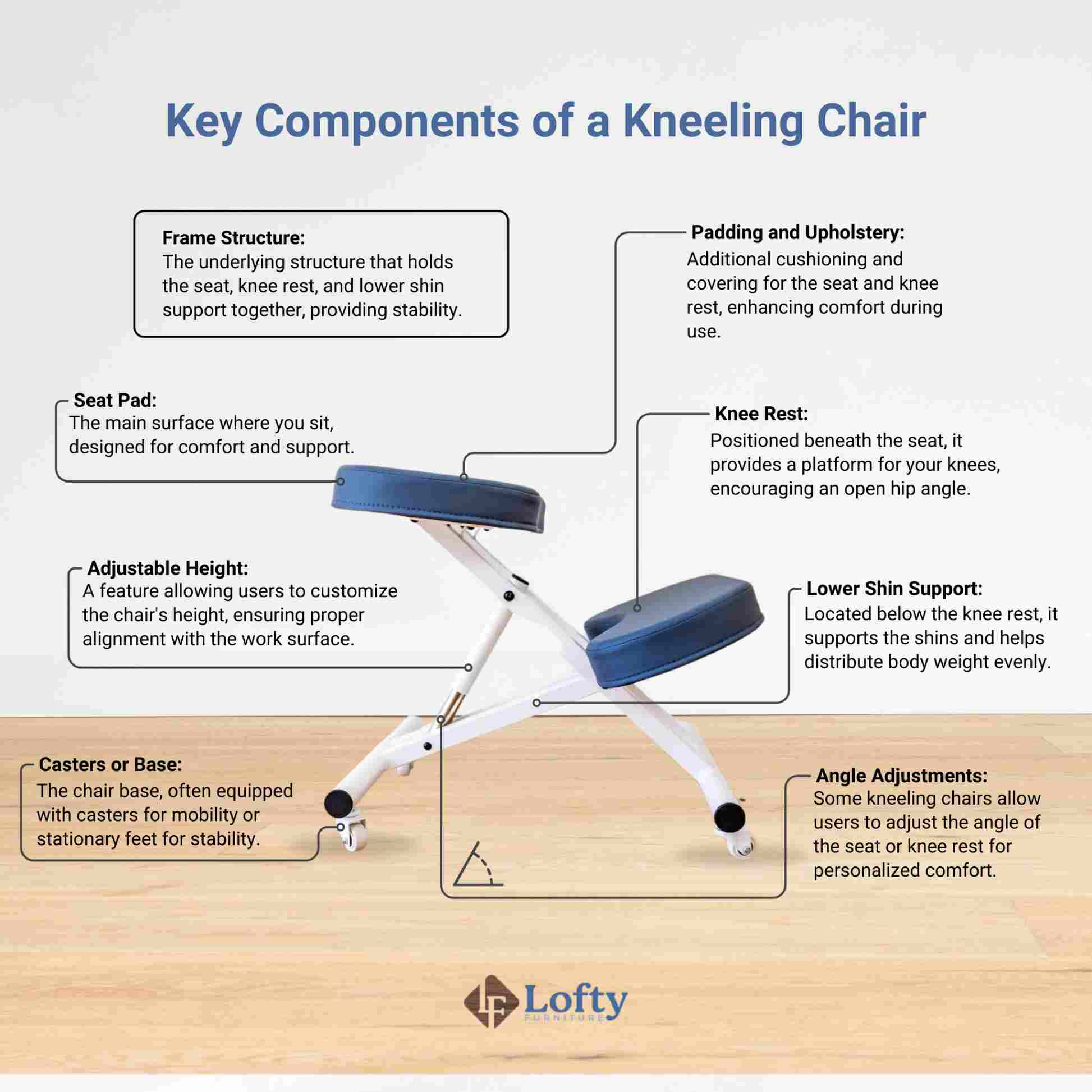
What are The Benefits of Using a Kneeling Chair?
Using a kneeling chair can bring about several benefits for your overall well-being.
Improved Posture
Kneeling chairs are designed to encourage a more open hip angle and upright spine, which can help reduce pressure on the lower back and promote better posture. By distributing weight between the seat and knee rest, they reduce the tendency to slouch and often engage the core for added stability. While results vary from person to person, many find that kneeling chairs support a healthier sitting position.
Reduced Back Pain
Using a kneeling chair helps align the spine and reduce strain on the lower back, which can alleviate existing back pain and prevent further discomfort. The improved posture and weight distribution relieve pressure on spinal discs, allowing for more comfortable sitting and increased focus throughout the day. Remember to take breaks and move regularly for the best results.
Enhanced Ergonomics
The angled seat of a kneeling chair encourages proper alignment of the back, shoulders, and neck, reducing tension in those areas. With added cushioning and better weight distribution, users often experience fewer pressure points and improved circulation. Choosing a chair with adjustable height and solid support ensures maximum ergonomic benefit.
Enhanced Core Strength
Sitting on a kneeling chair naturally activates your core muscles as you balance and maintain posture, helping to build strength over time. A strong core supports spinal health and reduces the risk of injury, making daily sitting more stable and sustainable. Some users also incorporate light exercises or tools like resistance bands to further engage their core while seated.
Increased Circulation
The forward-angled design of kneeling chairs positions the legs lower than the hips, encouraging blood flow and reducing pressure on veins. This improved circulation can minimize swelling, muscle fatigue, and discomfort during long periods of sitting. Better blood flow also helps deliver oxygen and nutrients throughout the body, supporting overall health and comfort.
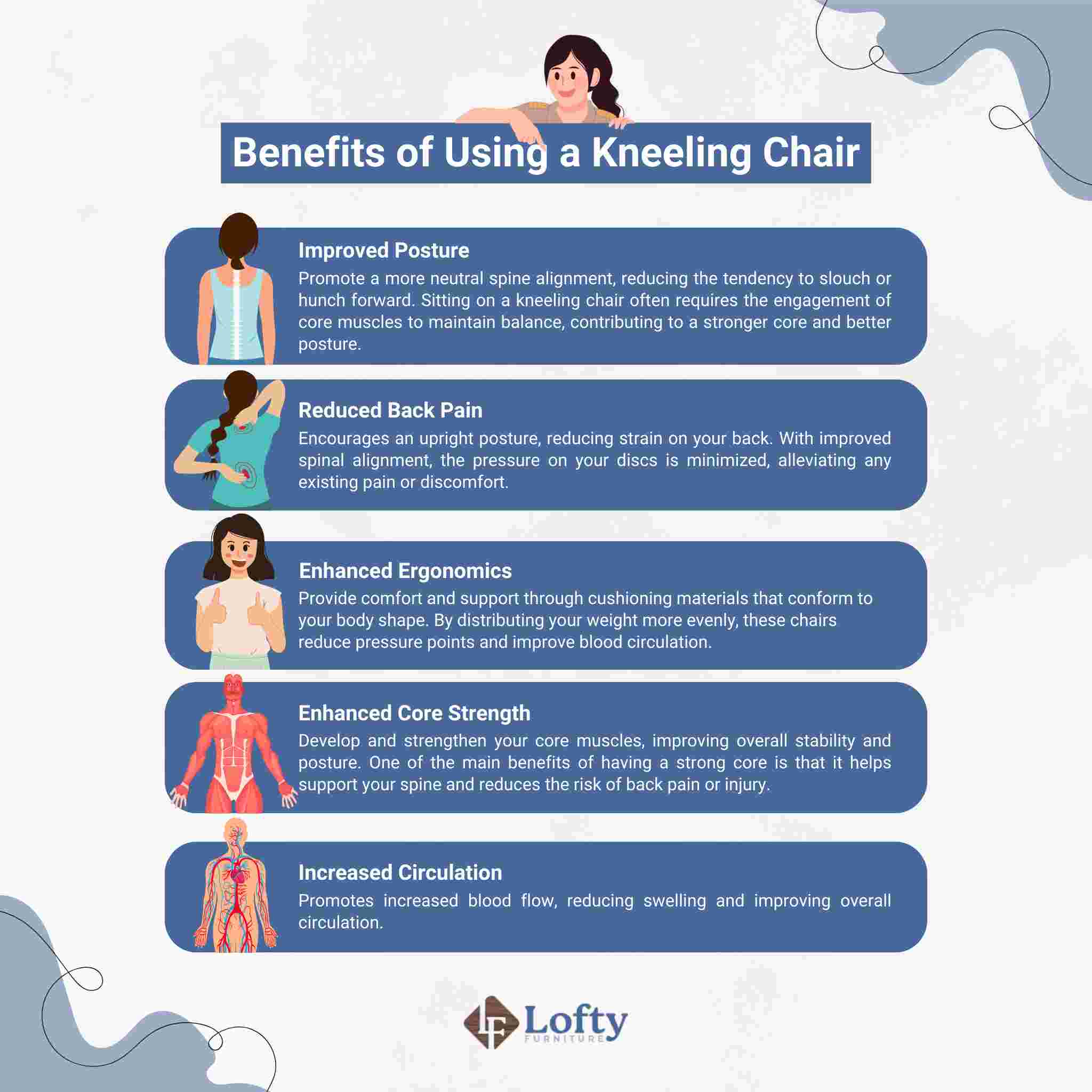
When Not to Use a Kneeling Chair
While kneeling chairs offer numerous ergonomic benefits, they aren’t ideal for everyone or every situation. Individuals with pre-existing knee, shin, or joint issues may experience discomfort or increased pressure in the lower legs due to the forward-tilted posture and shin rest design. Those with poor circulation or varicose veins may also find the restricted leg movement problematic during extended periods of use. Pregnant individuals, seniors with limited mobility, and anyone recovering from lower-body injuries should consult a medical professional before incorporating a kneeling chair into their routine.
How to Sit on A Kneeling Chair
To sit correctly on a kneeling chair, start by adjusting the seat height so that your feet are flat on the floor and your knees are at a 90-degree angle.
Next, align the knee and shin pads to ensure proper support for your lower body. Position the backrest to provide optimal support for your back, keeping it straight and aligned with your spine. Finally, distribute your weight evenly between your hips and knees to maintain balance and prevent strain on any one area of your body.

Sitting correctly on a kneeling chair can make a big difference in comfort, posture, and overall support—here’s the best way to do it.
1. Adjust Seat Height
Set the seat height so your feet rest flat on the floor and your knees are at about a 90-degree angle. Sit near the edge with your back straight and feet shoulder-width apart for balanced support; use a footrest if your feet don’t reach the ground.
2. Align the Knee and Shin Pads
Make sure the knee and shin pads are directly under your knees to avoid pressure. Your thighs should be parallel to the floor, and adding a cushion or lumbar pillow can improve comfort and support your lower back.
3. Position the Backrest for Support
If your chair has a backrest, adjust it to support your lower back without pushing you forward or back. Sit upright with your core engaged and feel a gentle hip stretch while leaning slightly forward.
4. Ensure Proper Weight Distribution
Distribute your weight evenly between your knees and buttocks by adjusting the seat and pads. Match the chair height to your desk to avoid leaning forward, and set a comfortable seat angle that encourages good posture.
Ready to experience the full benefits of proper posture? Check out our top-rated ergonomic kneeling chair and transform your sitting experience today!
Common Mistakes to Avoid
When sitting on a kneeling chair or any ergonomic chair, avoiding slouching is vital as it can strain your back and neck muscles. These are the common mistakes to avoid when sitting in a kneeling chair.
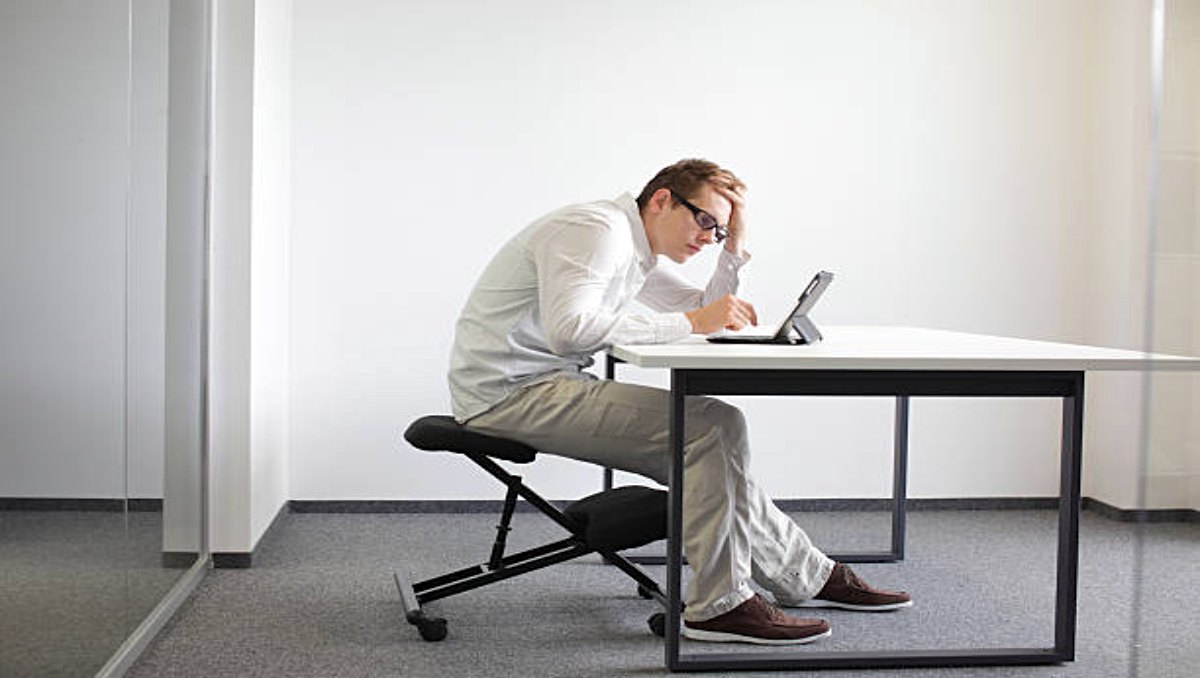
Slouching on the Kneeling Chair
Slouching or leaning too far forward or back puts unnecessary pressure on your spine. Instead, keep your shoulders slightly back and your core active to evenly distribute your weight and protect your back.
Ignoring Chair Adjustments
Properly adjusting your kneeling chair is essential for comfort and posture. Make sure your feet are flat on the floor and your knees are bent at about 90 degrees to promote spinal alignment and balance.
Overlooking the Importance of Breaks and Movement
Taking regular breaks to move around helps prevent stiffness and keeps your body energized. Short activity breaks improve circulation, reduce fatigue, and boost focus throughout the day.
Failing to Use Additional Support Tools
Using extra support like ergonomic cushions, lumbar rolls, or footrests can enhance comfort and help maintain proper posture, reducing strain on your knees and lower back while sitting.
Ergonomic Accessories for Kneeling Chairs
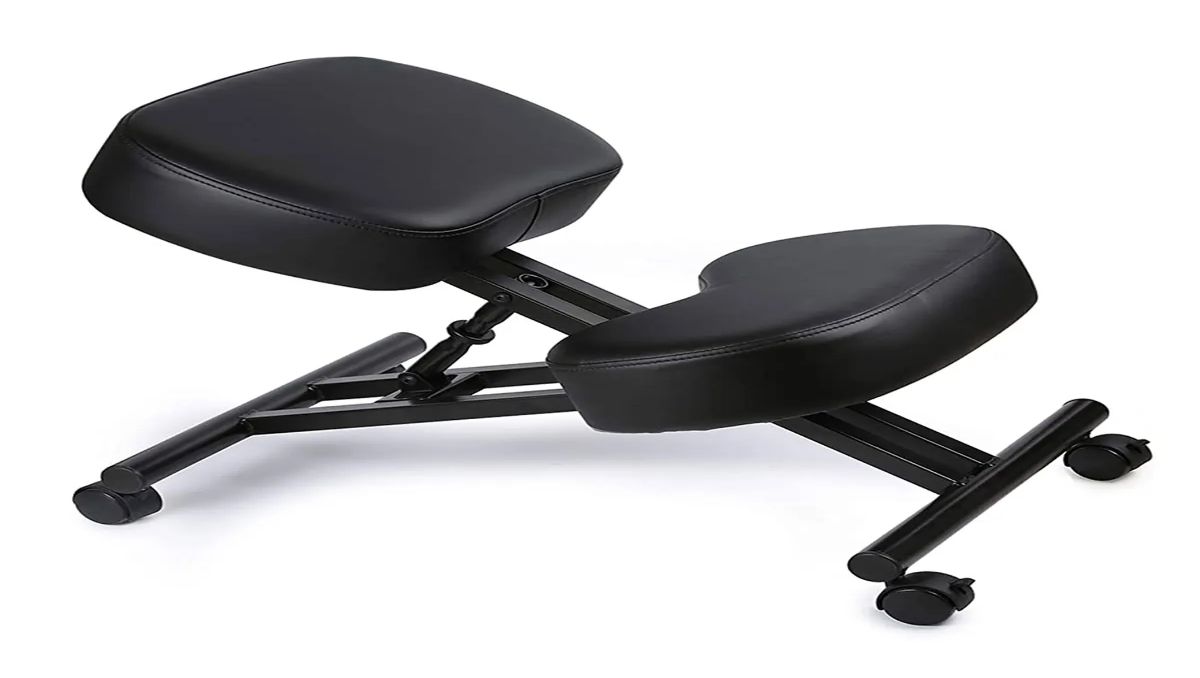
Consider incorporating ergonomic accessories into your seating arrangement to optimize your comfort and support while using a kneeling chair. These accessories can relieve knee pain and enhance the benefits of using a kneeling chair.
One essential accessory is an ergonomic cushion explicitly designed for kneeling chairs. This cushion provides extra padding to alleviate pressure on your knees and distribute your weight more evenly. It also promotes proper sitting posture by keeping your spine aligned and reducing strain on your back.
Another helpful accessory is a height-adjustable desk or keyboard tray. By adjusting the height of your workstation to match the level of your kneeling chair, you can maintain proper ergonomics and prevent discomfort in your neck.
Additionally, a footrest can enhance the benefits of sitting on a kneeling chair. A footrest allows you to elevate one or both feet, relieving pressure on your legs and improving circulation.
By incorporating these ergonomic accessories into your seating arrangement, you can maximize the comfort and support a kneeling chair provides.
If you find that sitting for extended periods still doesn’t suit your preferences, you might want to explore alternative options like standing desks.
Tips for Prolonged Sitting on a Kneeling Chair
If you want to experience the joys of feeling like an enlightened yogi while sitting for extended periods, here are some tips for getting the most out of your kneeling chair.
- Sitting duration is essential when using a kneeling chair. It is recommended to gradually increase your sitting time to allow your body to adjust.
- Proper alignment is critical to maximizing the benefits of a kneeling chair. Ensure both knees are comfortably resting on the knee pad and your hips are slightly tilted forward. This helps maintain proper spinal alignment and reduces strain on your back.
- Adjusting your kneeling chair correctly is crucial for optimal comfort. You can also experiment with different angles by adjusting the seat tilt or using additional cushions for support.
- Consider using ergonomic accessories such as lumbar pillows or seat cushions to maintain comfort during prolonged sitting. These can provide extra support and alleviate pressure points.
- Incorporating stretching exercises into your routine can help prevent stiffness and promote blood circulation. Take regular breaks to stretch your legs, back, and neck muscles.
Integrating Movement and Dynamic Sitting with Your Kneeling Chair
Even though a kneeling chair helps support better posture, the real key to healthy sitting is keeping your body moving. Try shifting your weight, gently rocking, or doing small stretches while seated. It keeps your muscles active and prevents stiffness.
Set a reminder every 30 to 60 minutes to stand up, stretch, or take a quick walk—even just to grab some water. And if you can, mix things up with a workstation that lets you switch between your kneeling chair, a standing desk, or a regular chair. Changing positions throughout the day helps your body stay comfortable, boosts circulation, and makes a big difference in how you feel. Plus, you can also do these exercises:

Sitting Smarter: Your 4-Step Kneeling Chair Guide
Sitting on a kneeling chair can significantly benefit your posture and overall comfort. By following the proper way to sit, you can achieve a more ergonomic position that promotes posture and spinal alignment. Avoiding common mistakes is crucial for maximizing the benefits of this chair.
Additionally, consider using ergonomic accessories to enhance your sitting experience even further. Remember, finding balance and stability in your seated position is key.
Ready to enhance your workspace further?
Explore our collection of ergonomic desks at Lofty Furniture for the perfect fit!
Frequently Asked Questions
How long should I sit in a kneeling chair each day?
Initially, start with short periods (e.g., 30-60 minutes) and gradually increase as your body adjusts. Aim for a mix of sitting, standing, and movement throughout the day.
Can a kneeling chair replace my traditional office chair entirely?
While it can be your primary chair, it’s often best used as part of a multi-posture approach. Alternating between a kneeling chair, a standing desk, and even a traditional ergonomic chair can provide the most comprehensive benefits.
Is it normal to feel some discomfort when first using a kneeling chair?
Yes, mild discomfort in your shins or knees can be normal as your body adjusts to the new posture and weight distribution. This usually subsides within a few days to a couple of weeks. If pain persists or is sharp, re-check your adjustments or consult a professional.
Can pregnant women use a kneeling chair?
It’s best for pregnant women to consult their doctor or physical therapist before using a kneeling chair, as body changes during pregnancy can affect balance and spinal alignment.
